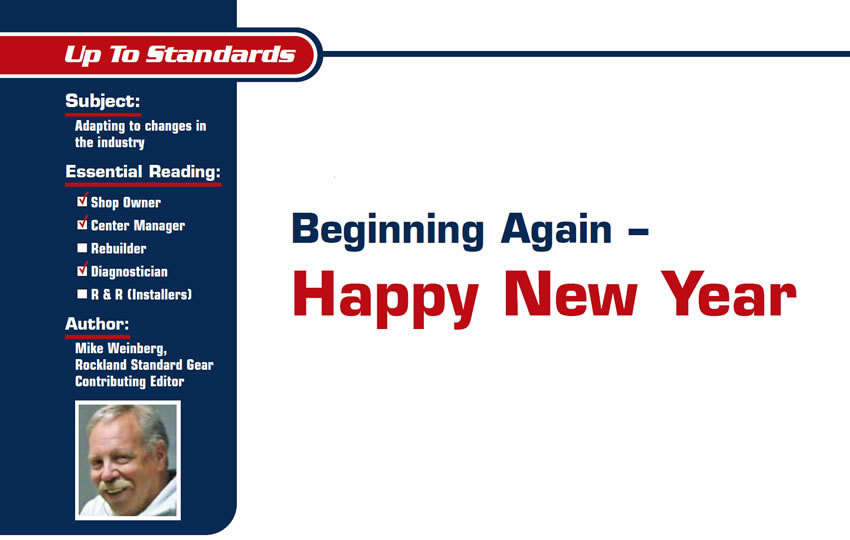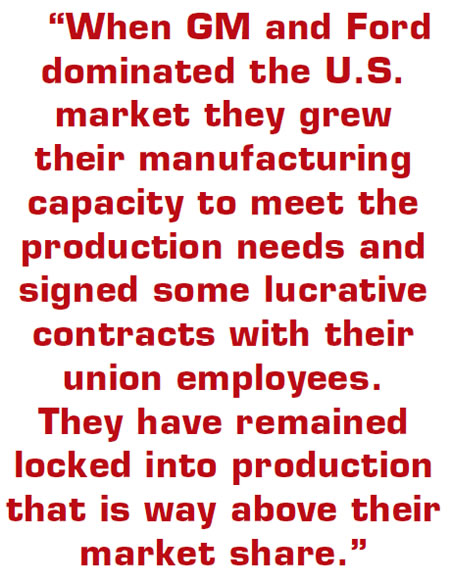
Up To Standards
- Subject: Adapting to changes in the industry
- Essential Reading: Shop Owner, Center Manager, Diagnostician
- Author: Mike Weinberg, Rockland Standard Gear, Contributing Editor
2005 is now in the history books, and I hope all of our readers enjoyed the holidays. It is a time-worn habit to make resolutions and try to improve our situations for the new year.
Time is a human creation. All other forms of life and some primitive tribes do not have any understanding of time. They are driven by instinct, seasonal changes and their life cycles, but we are the only species that has created the concept of time. This ability to measure each day precisely and then make future plans is a blessing and, at the same time, the source of tremendous pressure, which is self-induced.
Time is a great equalizer, as no one has any more time than anyone else, and success can be measured by the most-efficient use of time. What has really changed between Dec. 31 and Jan. 1? Absolutely nothing, except for a mark we made on the calendar. The problems and challenges we face in business and our personal lives are continuing, and this is a good thing. If you wake up breathing it is a great day.
The first of the year typically brings, in our mind, a fresh start, even though it is a continuous time cycle. Now is a great time to evaluate what we do well and what we need to do better, or perhaps stop doing. Our industry is in a great state of change. One constant is that there is always change, which is ongoing with the growth of technology, but 2005 saw some huge problems surface in the marketplace that have a direct impact on your business.

The first issue was the large increase in the price of oil, which has a direct impact on the driving habits of the public and the types of cars they will buy. Regardless of the gloom and doom in the media, there is no shortage of oil. There are shortages in refinery capacity. Because of pressure from the environmental movement, it has been almost 40 years since a new refinery was built in this country. The destruction caused by the hurricanes created an even bigger shortage in refining capability as many southern refineries were knocked off line for repairs.
The second cause of high oil prices is the global economy. China, India and Brazil are now experiencing huge growth in their manufacturing sector because of their cheaper labor costs. These and other countries are actively bidding on oil supplies, and with the growth of demand there is a growth in price. The price of fuel has a direct impact on all other prices, as freight costs rise, home heating fuel rises and our in-country overhead increases. This has led to higher steel and utility prices, which in turn have put further pressure on the economy. The parts, freight, and utility costs you are paying directly affect your profits, and you probably cannot pass all these costs on to your customers and remain competitive.
Insurance premiums also are rising as a direct result of the huge losses encountered by the insurance companies with last year’s hurricane season. What these companies pay out will cause them to raise their premiums to recover the losses. Since most states require repair facilities to maintain garage-liability coverage, all of our costs for insurance will go up. Your customers also will pay more for auto and homeowner insurance.
The next issue that will create a massive change for us in the transmission industry is the poor economic health of the Big 3 automakers. For a number of years GM, Ford and Chrysler have been selling vehicles by bribing the public with incentives. Zero down, no-interest loans and leases, cash back and “employee discounts” for everyone have been affecting our industry for years.
As you know, it takes a real salesman to sell an expensive transmission repair to someone with a high-mileage vehicle, when for no money down they can be in a new car with a long warranty. We have seen shops losing jobs all over the country as customers decide to put their money into a new vehicle.
The second part of this scenario is that because of longer warranties on new vehicles, you probably will not see any of these customers for three to five years. This incentive selling spree is caused by two factors primarily. The first is excess capacity and labor contracts. When GM and Ford dominated the U.S. market they grew their manufacturing capacity to meet the production needs and signed some lucrative contracts with their union employees. They have remained locked into production that is way above their market share. To move the vehicles, they have to create “giveaway” programs. You cannot build production for 57% market share when you have only 42%.
Now the chickens are coming home to roost. We see Ford announcing that it will cut its work force by 30,000 jobs and close plants. GM stock is rated lower than junk bonds at present, and the company has huge unfunded pension and health-care costs. This has already resulted in the bankruptcy of several huge suppliers to these companies. Collins & Aikman, a huge supplier of interiors and trim for the automakers, is gone. Delphi, which supplies GM with a great deal of its parts, has filed for a $29-billion bankruptcy. This means that the 1,000-plus companies that supply Delphi (which was created when GM spun off the old AC Delco division into a standalone company) cannot get paid immediately for outstanding invoices. They eventually will get paid at some discounted percentage and will have to obtain their own financing to remain in business. Any of these companies that cannot find financing will stop operation, and this probably will cause GM to shut down plants and car lines.
There is the question of labor contracts with the UAW and other unions. Delphi wants wage and benefit concessions from the unions, and this will be a long, tough battle. If any part of the work force strikes, a number of GM and Delphi plants will have to close. GM has health-care and retirement costs of more than $1,500 for each vehicle it builds. This is caused by contracts written over the years that provided the employees with retirement benefits and lifetime health-care coverage. Because of the continued increases in health-care costs and the increase in the average life span of the work force, the fringe benefits have gone out of control from a cost basis.
GM, Ford and Chrysler will not go out of business, but they will emerge from this mess as much smaller, more-efficient companies. The fate of the unions will go the same way. Union executives will have to work with the manufacturers to ensure their members continued employment. The manufacturers will have to begin making car lines that people want to buy to compete with foreign manufacturers that have U.S. plants with no union involvement and a younger work force that is not weighed down with huge “legacy” costs.
What does all this mean to our industry? We as a nation are tied to the automobile and its manufacturing sector. We will definitely share the fate of the factories. It is important for our industry to position itself to ride out these difficult times and to find the same efficiencies to lower our costs of doing business. We all will face rising costs for labor, health care and overhead. Learning to price your work to ensure a real net profit will be an absolute necessity. Studying the services you offer to your customers to make sure they are giving you an efficient and sufficient return on investment will be a must.
Are there areas on which you spend time and money without a good return? Maybe they should be discontinued and replaced with other repair work that is more profitable. Can you run a leaner operation and increase your net income? Absolutely, as every dollar saved goes right to your bottom line.
For instance, becoming a better diagnostician can earn you more dollars while cutting your costs in wasted labor and lost opportunities. Every supplier of remanufactured units sees a good percentage of cores returned with nothing wrong, or at least not enough wrong to have replaced it. The tech lines for these suppliers frequently are getting calls that start with, “The unit you shipped me is doing the same thing.” In most instances you have a noise, an electronic failure or related parts failure that was not diagnosed correctly, resulting in a lot of wasted hours. All the time you put into learning to identify the cause of the problem will bring back a huge future return to your profits, and to your job security.
A common problem that arises in difficult economic periods results in shops trying to save every dime on their parts purchases. Buying cost efficiently is always good policy, but never at the expense of quality, for the comeback costs will destroy many times the savings obtained.
Examine your advertising to make sure you are actually getting a return on your investment. Create an image of great customer service, and make it the cornerstone of everything you do. People will respond to courtesy and treatment that is well beyond what they are used to. Look at the services and needs that are going unfulfilled in your area and see whether you can provide them. The business or job you save may be your own.
As the parties involved are working out this crisis in manufacturing, what can we expect in the coming year or two? Building to market-share requirements will be a must for the Big 3. There will be a big push for more-fuel-efficient hybrid vehicles, but the cost of hybrids will outweigh the fuel savings they achieve.
There are a lot of incentive programs that are going to get cut, and some of this may result in more work for us. As these programs wind down, people may tend to keep cars longer, which will result in an increase in repairs needed. A great many car owners have rolled over lease and purchase plans several times and are now “upside down” on their vehicles. This means that they owe more on the car than its market value, which results in repairs instead of trade-ins.
New and more-demanding technology will create an even greater gap in the shortage of qualified technicians. The dealerships have no better chance at attracting qualified help than you do, so anyone who begins to create an apprenticeship program in their shop to attract entry-level people will come out ahead.
Nothing here is easy, but then nothing worthwhile ever is. We have opportunity, and I sincerely hope that all of you have continued good health. We live in the greatest country in the world. That is not just national pride speaking, because nowhere on earth can you obtain the freedom and economic opportunity we take for granted. If this is not true, why are people from every country risking all they have to come here? Be thankful for what you have and for those who work to protect us from outside forces who would try to reduce us to their level. We have been given another year to do better; take every advantage of it.














